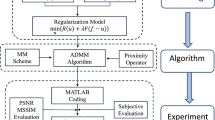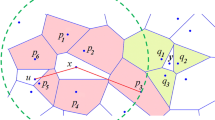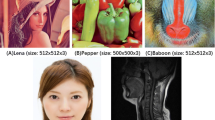Abstract
We propose a new model for removing the Salt and Pepper Noise (SPN) by combining the high-order total variation overlapping group sparsity with the nuclear norm regularization. Since the proposed model is convex, non-smooth, and separable, the alternating direction method of multipliers (ADMM) can be employed to solve it and the convergence can be kept. Numerical comparisons with some related state-of-the-art models show that the proposed model can significantly improve the restored quality in terms of the signal to noise ratio (SNR) and the structural similarity index measure (SSIM).








Similar content being viewed by others
Notes
This paper assumes that the image is normalized into the range [0,1].
In the numerical implementations, we set \(\mathbf{q} ^0=\nabla ^2f\) and \(h^0, r^0, \varrho _1^0,\varvec{\varrho }_2^0,\varrho _3^0\) be the zero matrix and tensor.
To quantitatively assess the image quality, we adopt the Signal to Noise Ratio (SNR) and the Structural Similarity Index Measure (SSIM) based on the Matlab functions as \(snr(\cdot )\) and \(ssim(\cdot )\).
References
Amiri S (2019) Salt and pepper noise removal using pixon-based segmentation and adaptive median filter. J AI Data Min 8(1):119–126
Arridge S, Maass P, Oktem O, Schonlieb C (2019) Solving inverse problems using data-driven models. Acta Numer 28:1–174
Athey S, Bayati M, Doudchenko N, Imbens G, Khosravi K (2021) Matrix completion methods for causal panel data models. J Am Stat Assoc 116(536):1716–1730
Bakushinsky A, Kokurin M, Kokurin M (2018) Regularization Algorithms for Ill-Posed Problems. De Gruyter
Bandala-Hernandez H, Rocha-Pérez J, Díaz-Sánchez A (2016) Weighted median filters: an analog implementation. Integration 55:227–231
Beck A (2014) Introduction to Nonlinear Optimization: Theory, Algorithms, and Applications with MATLAB. SIAM
Bini A (2019) Image restoration via DOST and total variation regularisation. IET Image Proc 13(3):458–468
Boyd S, Parikh N, Chu E, Peleato B, Eckstein J (2011) Distributed optimization and statistical learning via the alternating direction method of multipliers. Found Trends Mach Learn 3(1):1–122
Bredies K, Holler M (2021) Higher-order total variation approaches and generalisations. Inverse Prob 36(12):123001
Bredies K, Kunisch K, Pock T (2010) Total Generalized Variation. SIAM J Image Sci 3(3):492–526
Buades A, Coll B, Morel J (2006) The staircasing effect in neighborhood filters and its solution. IEEE Trans Image Process 15(6):1499–1505
Cai J, Candés E, Shen Z (2010) A singular value thresholding algorithm for matrix completion. SIAM J Optim 20(4):1956–1982
Chambolle A, Lions P (1997) Image recovery via total variation minimization and related problems. Numer Math 76(2):167–188
Chan T, Esedoglu S (2005) Aspects of total variation regularized \(L^{1}\) function approximation. SIAM J Appl Math 65(5):1817–1837
Chan R, Ho C, Nikolova M (2005) Salt-and-pepper noise removal by median-type noise detectors and detail-preserving regularization. IEEE Trans Image Process 14(10):1479–1485
Chen C, He B, Ye Y, Yuan X (2016) The direct extension of ADMM for multi-block convex minimization problems is not necessarily convergent. Math Program 155(1–2):57–79
Erkan U, Gokrem L, Enginoglu S (2018) Different applied median filter in salt and pepper noise. Comput Electr Eng 70:789–798
Gabay D, Mercier B (1976) A dual algorithm for the solution of nonlinear variational problems via finite element approximation. Comput Math Appl 2(1):17–40
Glowinski R, Marroco A (1975) Sur lapproximation, par éléments finis dordre un, et la résolution, par pénalisation-dualité, dune classe de problèmes de Dirichlet non linéares. ESAIM Math Model Numer Anal 9(R2):41–76
Glowinski R, Osher S, Yin W (2016) Splitting Methods in Communication. Science, and Engineering. Springer, New York (Imaging)
Goyal G (2016) Improved image denoising filter using low rank and total variation. Global J Comp Sci Technol 16(1):13–15
Guo X, Li F, Ng M (2009) A fast \(l\)1-TV algorithm for image Restoration. SIAM J Sci Comput 31(3):2322–2341
Guo W, Qin J, Yin W (2014) A new detail-preserving regularization scheme. SIAM J Imag Sci 7(2):1309–1334
Hager W, Hearn W, Pardalos P (1994) Large Scale Optimization. Springer, New York
Han D (2022) A survey on some recent developments of alternating direction method of multipliers. J Oper Res Soc China. https://doi.org/10.1007/s40305-021-00368-3
Jia X, Feng X, Wang W (2016) Rank constrained nuclear norm minimization with application to image denoising. Signal Process 129:1–11
Kongskov R, Dong Y (2017) Directional total generalized variation regularization for impulse noise removal. Scale Space Var Methods Comput Vis 10302:221–231
Liu P (2020) Hybrid higher-order total variation model for multiplicative noise removal. IET Image Proc 14(5):862–873
Liu G, Huang T, Liu J (2014) High-order TVL1-based images restoration and spatially adapted regularization parameter selection. Comput Math Appl 67(10):2015–2026
Liu G, Huang T, Liu J, Lv X (2015) Total variation with overlapping group sparsity for image deblurring under impulse noise. PLoS One 10(4):e0122562
Liu J, Huang T, Selesnick I et al (2015) Image restoration using total variation with overlapping group sparsity. Inf Sci 295:232–246
Lu C, Tang J, Yan S, Lin Z (2016) Nonconvex nonsmooth low rank minimization via iteratively reweighted nuclear norm. IEEE Trans Image Process 25(2):829–839
Palomar D, Eldar Y (2011) Convex Optimization in Signal Processing and Communications. Cambridge University Press, Cambridge
Parisotto S, Masnou S, Schönlieb C (2020) Higher-order total directional variation:analysis. SIAM J Imag Sci 13(1):474–496
Peyré G, Fadili J (2011) Group sparsity with overlapping partition functions. In: European Signal Processing Conference, 303–307
Ryu E, Liu Y, Yin W (2019) Douglas-Rachford splitting and ADMM for pathological convex optimization. Comput Optim Appl 74:747–778
Selesnick I, Chen P (2013) Total variation denoising with overlapping group sparsity. In: IEEE International Conference on Acoustics, Speech, and Signal Processing, 5696–5700
Sreedevi S, Sherly E (2020) A new and efficient approach for the removal of high density impulse noise in mammogram. J Comput Aided Eng Technol 12(3):370–391
Srinivasan K, Ebenezer D (2007) A new fast and efficient decision-based algorithm for removal of high-density impulse noises. IEEE Signal Process Lett 14(3):189–192
Toh K, Isa N (2010) Noise adaptive fuzzy switching median filter for salt-and-pepper noise reduction. IEEE Signal Process Lett 17(3):281–284
Toh K, Ibrahim H, Mahyuddin M (2008) Salt-and-pepper noise detection and reduction using fuzzy switching median filter. IEEE Trans Consum Electron 54(4):1956–1961
Wang S, Wu C (2009) A new impulse detection and filtering method for removal of wide range impulse noises. Pattern Recogn 42(9):2194-2202
Wang G, Li W, Huang Y (2021) Medical image fusion based on hybrid three-layer decomposition model and nuclear norm. Comput Biol Med 129:104179
Yin W, Goldfarb D, Osher S (2007) The total variation regularized \(L^{1}\) model for multiscale decomposition. Multiscale Model Simul 6(1):190–211
Zhang S, Karim M (2002) A new impulse detector for switching median filters. IEEE Signal Process Lett 9(11):360–363
Acknowledgements
We would like to thank Dr. Zhi-Feng Pang of Henan University for his suggestions on the numerical implementations. This work is partially supported by Programs for Science and Technology Development of Henan Province (Nos.212102210511, 212102310652) and Health Commission of Henan Province (No.Wjlx2020380).
Author information
Authors and Affiliations
Corresponding authors
Additional information
Communicated by Vinicius Albani.
Publisher's Note
Springer Nature remains neutral with regard to jurisdictional claims in published maps and institutional affiliations.
Haohui Zhu and Baoli Shi contributed equally to this work and should be considered as corresponding authors.
Appendices
Appendix A
Proof
Based on the property of the nuclear norm \(\Vert \cdot \Vert _*\) and \(\phi (\cdot )\) as the extension of the Frobenius norm, we first can deduce that the objective function in the model (2) is strictly convex. For \(u\in \ell ^1(\mathbf{X} )\), the objective function is also coercive whenever u goes to infinity in the fitting term \(\Vert u-f\Vert _1\). Following the standard numerical optimization theory Beck (2014), we can deduce that the model (2) exists a global solution. \(\square \)
Appendix B
Proof
Since \((h^{*},{\mathbf {q}}^{*},r^{*},u^{*},\varrho _{1}^{*},\varvec{\varrho }_{2}^{*},\varrho _{3}^{*})\) is the saddle point of the original problem, we can deduce \(h^{*}=u^{*}-f\), \({\mathbf {q}}^{*}=\nabla ^{2} u^{*}\), \(r^{*}=u^{*}\) and then (10)–(12) can be replaced by
If setting the relative errors by \(h_{e}^{k}=h^{k}-h^{*}\), \({\mathbf {q}}_{e}^{k}={\mathbf {q}}^{k}-{\mathbf {q}}^{*}\), \(r_{e}^{k}=r^{k}-r^{*}\), \(u_{e}^{k}=u^{k}-u^{*}\), \(\varrho _{1e}^{k}=\varrho _{1}^{k}-\varrho _{1}^{*}\), \(\varvec{\varrho }_{2e}^{k}=\varvec{\varrho }_{2}^{k}-\varvec{\varrho }_{2}^{*}\), \(\varrho _{3e}^{k}=\varrho _{3}^{k}-\varrho _{3}^{*}\), and subtracting (18) from (10)–(12), we can obtain that
Squared both sides of (19), we can obtain that
The above facts can be equivalently expressed as follows.
Based on Lemma 4, for the saddle point \(\left( h^{*},{\mathbf {q}}^{*},r^{*},u^{*},\varrho _{1}^{*},\varvec{\varrho }_{2}^{*},\varrho _{3}^{*}\right) \), we can get
To the subproblem (6), using Lemma 4 again, we can get
By first setting u of the forth inequation in (21) to be \(u^{k+1}\) and u in (22) to be \(u^*\) and then adding them, we can deduce that
Similarly, we have

Summing (23) with (24)–(26) together, we have
Reorganizing the inequation (27), we can get
Combining (20) with (28), we have
With the simple calculation, we obtain
Similar to the subproblem (7), using Lemma 4 again, we still have

Setting \(h:=h^{k}\) in (21) and \(h:=h^{k+1}\) in (22) and then adding them, we can deduce that
Using the fact \(\varrho _{1e}^{k}=\varrho _{1e}^{k-1}+\beta _{1}(h_{e}^{k}-u_{e}^{k})\), the inequation (32) can be rearranged as
Furthermore, using
the inequation (33) can be written as
Similarly, we have
By putting (34) and (35) into (29), with the simple recombination, we can get
The above inequation is added from the \(k=0\) to the \(k=M\), we have
Above inequation can furthermore shrunken as
Using the boundedness on the left of (36), we have
and
Due to the saddle point \((h^{*},{\mathbf {q}}^{*},r^{*},u^{*},\varrho _{1}^{*},\varvec{\varrho }_{2}^{*},\varrho _{3}^{*})\), the limitations in (37) furthermore imply that
Based on the convexity of the primal problem in the problem (4), there exists a convergent sequence, without loss of generality by still setting \(\left( u^{k},h^{k},{\mathbf {q}}^{k},r^{k}\right) \) such that
Now we need to show that \(\left( \bar{h}^\star ,{\mathbf {q}}^\star ,r^\star ,u^\star \right) \) is the saddle point of the problem (4). In fact, combining (10)–(12) with (38)–(39) and taking the limitation, we can deduce that
This implies that \(\left( h^{\star },{\mathbf {q}}^{\star },r^{\star },u^{\star },\varrho _{1}^{\star }, \varvec{\varrho }_{2}^{\star },\varrho _{3}^{\star }\right) \) is a saddle point. That is to say, we can set \(\left( h^{\star },{\mathbf {q}}^{\star },r^{\star },u^{\star },\varrho _{1}^{\star }, \varvec{\varrho }_{2}^{\star },\varrho _{3}^{\star }\right) :=\left( h^{\star }, {\mathbf {q}}^{\star },r^{\star },u^{\star },\varrho _{1}^{\star }, \varvec{\varrho }_{2}^{\star },\varrho _{3}^{\star }\right) .\) Following from Lemma 2, we can deduce that \(\{u^k\}\) converges to the solution of the problem (4). \(\square \)
Rights and permissions
About this article
Cite this article
He, L., Zhang, J., Zhu, H. et al. A new hybrid regularization scheme for removing salt and pepper noise. Comp. Appl. Math. 41, 173 (2022). https://doi.org/10.1007/s40314-022-01869-4
Received:
Revised:
Accepted:
Published:
DOI: https://doi.org/10.1007/s40314-022-01869-4
Keywords
- Image Restoration
- Salt and Pepper Noise (SPN)
- High Order Total Variation Overlapping Group Sparsity (HOTVOGS)
- Nuclear Norm (NN) Regularization
- Alternating Direction Method of Multipliers (ADMM)




